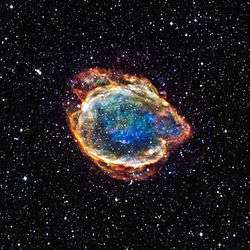Supernova Early Warning System
The SuperNova Early Warning System (SNEWS) is a network of neutrino detectors designed to give early warning to astronomers in the event of a supernova in the Milky Way, our home galaxy, or in a nearby galaxy such as the Large Magellanic Cloud or the Canis Major Dwarf Galaxy.
As of August 2016, SNEWS has not issued any Supernova alerts.
Enormous numbers of neutrinos are produced in the core of a red giant star as it collapses on itself. In the current model the neutrinos are emitted well before the light from the supernova peaks, so in principle neutrino detectors could give advance warning to astronomers that a supernova has occurred and may soon be visible. The neutrino pulse from supernova 1987A arrived 3 hours before the associated photons – but SNEWS was not yet active and it was not recognised as a supernova event until after the photons arrived.
There are currently seven neutrino detector members of SNEWS: Borexino, Daya Bay, KamLAND, HALO, IceCube, LVD, and Super-Kamiokande.[1] SNEWS began operation prior to 2004, with three members (Super-Kamiokande, LVD, and SNO). The Sudbury Neutrino Observatory is no longer active as it is being upgraded to its successor program SNO+.
The detectors send reports of a possible supernova to a computer at Brookhaven National Laboratory to identify a supernova. If the SNEWS computer identifies signals from two detectors within 10 seconds, the computer will send a supernova alert to observatories around the world to study the supernova.[2]
See also
- Near-Earth supernova
- History of supernova observation
- Timeline of white dwarfs, neutron stars, and supernovae
- Supernova nucleosynthesis
- Supernova neutrinos
References
- ↑ "SNEWS News". Brookhaven National Laboratory. 2015. Retrieved 2015-12-06.
- ↑ Jayawardhana, Ray. "Physicists Eagerly Await Neutrinos from the Next Nearby Supernova [Excerpt]". Retrieved 2015-10-07.
External links
- Official website
- Antonioli, P.; et al. (2004). "SNEWS: the SuperNova Early Warning System". New Journal of Physics. 6: 114–114. arXiv:astro-ph/0406214
 . Bibcode:2004NJPh....6..114A. doi:10.1088/1367-2630/6/1/114.
. Bibcode:2004NJPh....6..114A. doi:10.1088/1367-2630/6/1/114. - Francis Reddy, "Time for SNEWS", Astronomy 3 June 2005
- NOVA podcast about SNEWS (the same in MP3 format)
- Weeks, Erin (22 January 2014). "Supernova Explosion in M82: Exciting, but No Neutrinos". Duke University Research Blog. Retrieved 2015-12-06.

